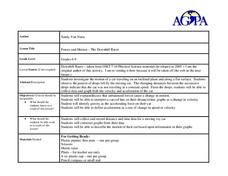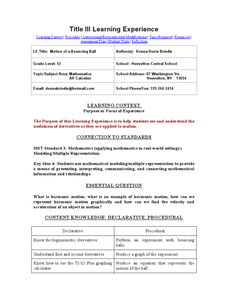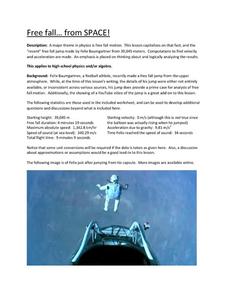Physics Classroom
Free Fall
Scholars must understand freefall before they learn how objects like airplanes fly. They apply knowledge of velocity and acceleration to predict speed and direction as part of a larger series on vectors and projectiles.
Curated OER
Circular Motion: Target Practice
Students demonstrate direction of velocity of an object in circular motion. They discuss the mathematical formula, and demonstrate the formula using a string, rubber stopper and a target.
Curated OER
Forces and Motion-The Downhill Racer
Students calculate a toy car's velocity and acceleration. For this force and motion lesson, students build ramps and attach a dropper to a toy car, which is released down the ramp. Students calculate and graph velocity and acceleration...
Curated OER
Projectile Motion Lab
For this physics worksheet, students model the position, velocity and acceleration using mathematical formulas and a computer program. Then they interpret the parameters in each of the models. Students also complete the experiment and...
Curated OER
Algebra-Based Linear Motion Problems
In this motion learning exercise, students determine the distance traveled, the acceleration, and velocity of different objects. This learning exercise has 11 problems to solve.
Curated OER
Linear Motion Problems
In this motion activity, students determine the speed, velocity, or acceleration of various objects under certain conditions. This activity has 7 word problems.
Curated OER
Motion
In this motion worksheet, learners will read 8 statements about displacement and velocity and determine if the statement is true or false. Then students will fill in the blank for 8 statements on motion. Finally, learners will compare...
Curated OER
Straight Line Motion with a Stomper
Young scholars explore average speed, and graph distances and time. In this speed and velocity lesson students complete a lab then calculate distances, acceleration and velocity and graph the data.
Curated OER
Motion Graphs
In this motion graphs worksheet, students learn about how motion of objects can be described using a graph. Students then answer 10 fill in the blank, 10 short answer, and 5 problems to solve.
Curated OER
Newton's Three Laws of Motion Lesson Plan
Students explore Newton's three laws of motion using a variety of activities. In this physics lesson, students calculate the average speed of a vehicle they constructed using distance and time information. They identify and draw the...
Curated OER
Motion Near Earth
In this motion worksheet, students will match 5 physics vocabulary words relating to motion with their definitions. Then, they will review 9 statements of different motion scenarios to determine is the statement is true or false....
Curated OER
Motion of a Bouncing Ball
Twelfth graders complete a unit of lessons on derivatives as they are applied to motion. They observe and discuss demonstrations, conduct an experiment involving a motion sensor, graph and analyze the results, and summarize their findings.
Curated OER
Motion on an Inclined Plane
In this physics worksheet, students model the acceleration, velocity, and position of a cart moving up an inclined plane. They take data and determine a pattern in the data. Students also describe their findings and create an illustration.
Curated OER
Position vs. Time and Velocity vs. Time Graphs
In this constant velocity worksheet, students use data of position vs. time of a roller-skater to determine speed, acceleration, or deceleration at different points along the path. Students rank graphs according to average velocity and...
National Council of Teachers of Mathematics
Varying Motion
For this secondary mathematics learning exercise, high schoolers collect data based on a person’s motion. From this data, learners create graphs comparing displacement, velocity, and acceleration to time. The five-page learning exercise...
Curated OER
Sliding Mass Problems
Physics masters solve five sliding mass problems. For each, there are a few different values to be determined: normal force, force of friction, acceleration, velocity, coefficient of friction, or net force. Pupils must draw a force...
University of Wyoming
Free Fall…From SPACE!/Nanotechnology in the Classroom
Provide the details about Felix Baumgartner's sky jump from the far reaches of our atmosphere, 39,045 meters up! Then get your physics free fallers to evaluate the factors that played a role in his acceleration, the time to reach maximum...
Curated OER
Vectors: Follow That Arrow
Vectors and their connection to motion. A video will be presented to provide information for the class to use methods of solving vectors with and without grids. Real-world physical concepts will be explored in reference to vectors.
Curated OER
Vector Investigation: Car Storm Chaser
Young scholars investigate the relationship between vectors and motion. In this geometry lesson, students create a system that exemplifies the principles of motion. They solve for the acceleration, velocity and displacement.
Physics Classroom
Trajectory - Angle Launched Projectiles
Horizontal and vertical speeds change as projectiles move through space. As part of a series on vectors and projectiles, scholars create vector diagrams to compare these speeds at various locations. They they determine the values for...
Curated OER
Acceleration, Drag, Gravity, Motion, Forces, and Friction
Eighth graders build and run mousetrap cars in order to measure distance, time, and mass for their cars. They use these measurements to calculate average speed and kinetic energy, then create a slide show to visually explain how the car...
Curated OER
Pendulum Motion
Students explore questions which cannot be handled with simple pendulums, and examine both the usefulness and the limitations of approximations in science. A Java applet created from a Stella model is included.
Curated OER
Speedy Spaghetti
Students explore the principles of motion by constructing a car out of pasta that will carry a large marshmallow and travel down a ramp. They discuss the formula for calculating speed, design and build their cars, and calculate their...
PHET
My Solar System
Orbit diagrams appear to be a work of mathematical art. The simulation helps scholars build their own systems of planets, stars, moons, etc., to observe their orbits. By altering their positions, velocities, and masses, a variety of...























